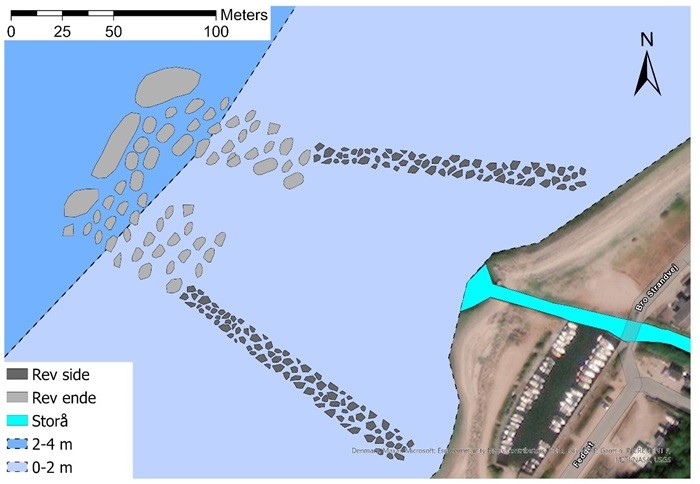A new research project will investigate whether rocky reefs near a river mouth can support sea trout during their dangerous migration from freshwater to the sea.
Every year, thousands of juvenile sea trout—also called smolts—migrate to the sea along Danish waterways. This migration from freshwater to saltwater is part of the sea trout’s natural lifecycle.
The young trout are typically 12-20 cm long and make a perfect meal for many predators. Trout are targeted by northern pike, zander, seal, mink, cormorant, and heron, and many of the juvenile trout are eaten on their way to sea and especially near the mouths of rivers. DTU Aqua has estimated that in many areas up to 50 per cent of juvenile trout are eaten by cormorants.
Now Lillebælt Nature Park, DTU Aqua, and local stakeholders will investigate whether a new rocky reef can improve the performance of the trout. The idea is that the reef will create better hiding places for the small fish when they leave the river and swim out to sea, so they can hide from their predators. The overall goal is to increase sea trout stocks and improve biodiversity, which will also benefit local recreational fishing.
The rocky reef will be established in 2022-2023 in Båring Vig on North Funen, at the mouth of the Storå River. This is part of the project “Belt in Balance”, which is supported by VELUX FONDEN.
The world’s first reef for juvenile sea trout
Many of Denmark’s natural marine rocky reefs were removed in the past and used for coastal constructions. In many places, therefore, the migrating trout encounter a marine environment with far too few hiding places.
“We are the first in the world to investigate whether the establishment of a rocky reef near a river mouth can give juvenile sea trout the hiding places they need, and whether this can improve their performance. We know from our other marine projects that rocky reefs both allow the fish to hide between the rocks and in the seaweed that grows on the rocks,” says Jon C. Svendsen, Senior Researcher at DTU Aqua.
In addition to giving the fish shelter, it is hoped that over time, the reef will become a large food store for the young trout and many other animals. Seaweed and mussels have difficulty growing on sandy seabeds, but can stick to the hard surfaces of rocky reefs and establish themselves. A seaweed forest can provide a home for up to 100,000 small animals per square metre.
Monitoring fish behaviour
To document the effects of the reef, the DTU Aqua researchers will examine the area before and after the rocky reef is established.
Before the reef is established, the researchers will temporarily catch juvenile trout in the Storå River near the estuary. The fish will be tagged with small transmitters each of which emits a unique signal every minute. After being tagged, the fish will be released so they can resume their downstream migration towards the sea.
The signals from the transmitters will be picked up by 25 listening posts that will be set up near the river mouth area. The data from these posts will then show where each individual fish stays and for how long time.
About 18 months after the reef is established, trout will be tagged again in the Storå River. This will allow the researchers to see whether there is a change in fish behaviour before and after the reef is established and how many of the fish that stay by the reef.
The reef as a whole will consist of around 4,200 m3 of rocks divided between two side reefs and a larger reef at the end.
The side reefs will consist of rocks with a diameter of about 40 cm. They will be distributed on the seabed within the dark-grey markings in the figure and will cover approximately 50 per cent of the seabed.
At the end of the side reefs, cave-forming reefs will be established at a depth of 3-4 metres. Here, rocks with a diameter of 40-70 cm will be used. The cave-forming reef will rise 1-1.5 metres up from the seabed. To allow boats to pass freely to and from Varbjerg Harbour, a sailing channel will be kept free of rocks close to the surface.
The reef will extend approximately 220 metres out from the beach. The longest distance between the side reefs will be about 190 metres by the coast.
